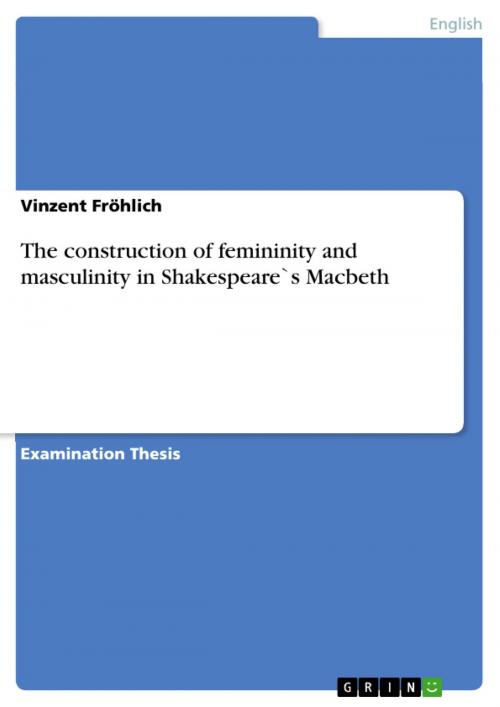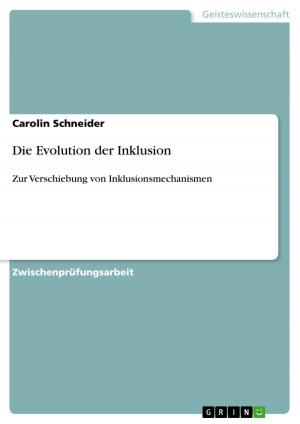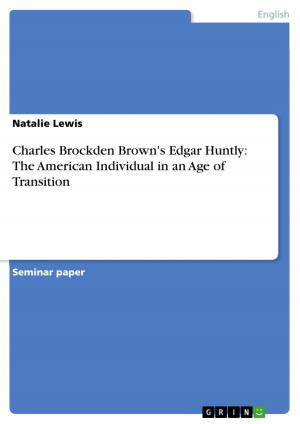The construction of femininity and masculinity in Shakespeare`s Macbeth
Fiction & Literature, Literary Theory & Criticism, British| Author: | Vinzent Fröhlich | ISBN: | 9783638057066 |
| Publisher: | GRIN Verlag | Publication: | June 3, 2008 |
| Imprint: | GRIN Verlag | Language: | English |
| Author: | Vinzent Fröhlich |
| ISBN: | 9783638057066 |
| Publisher: | GRIN Verlag |
| Publication: | June 3, 2008 |
| Imprint: | GRIN Verlag |
| Language: | English |
Examination Thesis from the year 2007 in the subject English Language and Literature Studies - Literature, grade: 2,0, University of Potsdam (Institut für Anglistik und Amerikanistik), 50 entries in the bibliography, language: English, abstract: The title of this paper is 'The Construction of Femininity and Masculinity in Shakespeare`s Macbeth'. As this title suggests, I analyzed how Shakespeare construes female and male identity in Macbeth. As in many Shakespearean dramas the play starts with the destruction of order leading up to a crisis and ending in the restoration of order at the end of the play (Gelfert 32). The political order that is destroyed in the course of the play is King Duncan`s natural and fair order which appreciates a unique set of masculine and feminine values. Macbeth murders King Duncan in order to usurp his throne. Macbeth`s reign turns Duncan`s order into chaos and moral order cannot return to Scotland until the tyrant ruler Macbeth is defeated by troops who fight for the restoration of Duncan`s order, through the coronation of his son Malcolm. This essay deals with the question of how Shakespeare shapes female and male characters. As a matter of fact, female and male characters are ultimately involved in the destruction and restoration of Scotland. This involves questions such as: Which historical concepts does Shakespeare use to construe his male and female characters? Does he construe 'typical' gender roles? And what happens when gender boundaries are crossed, when men develop feminine traits and women male ones? With special regard to the marriage of Macbeth and Lady Macbeth, I also analyzed the interaction between the genders. In the course of my analysis, I used the term 'gender', originating from Anglo-American feminist discourse, meaning 'the social, cultural, and psychological meaning imposed upon biological sexual identity' (Showalter 1-2). Interpreting femininity and masculinity as 'gender' constructions allows a more thorough analysis of the various processes involved in the 'making' of men and women. Whilst the term 'sex' suggests that children naturally acquire the appropriate masculine or feminine behavioural norms of their society, the term 'gender' can also indicate that some people feel discrepancies between their 'anatomical sex and experiential sense of gender and sexuality' (Showalter 2). After a short historical introduction about the origins of the play, I analyzed the masculine world of chivalry that the play takes place in. Understanding the world of chivalry, its values and codes is required as most of the male characters are construed as chivalrous knights serving in the corps of King Duncan. Enjoy!
Examination Thesis from the year 2007 in the subject English Language and Literature Studies - Literature, grade: 2,0, University of Potsdam (Institut für Anglistik und Amerikanistik), 50 entries in the bibliography, language: English, abstract: The title of this paper is 'The Construction of Femininity and Masculinity in Shakespeare`s Macbeth'. As this title suggests, I analyzed how Shakespeare construes female and male identity in Macbeth. As in many Shakespearean dramas the play starts with the destruction of order leading up to a crisis and ending in the restoration of order at the end of the play (Gelfert 32). The political order that is destroyed in the course of the play is King Duncan`s natural and fair order which appreciates a unique set of masculine and feminine values. Macbeth murders King Duncan in order to usurp his throne. Macbeth`s reign turns Duncan`s order into chaos and moral order cannot return to Scotland until the tyrant ruler Macbeth is defeated by troops who fight for the restoration of Duncan`s order, through the coronation of his son Malcolm. This essay deals with the question of how Shakespeare shapes female and male characters. As a matter of fact, female and male characters are ultimately involved in the destruction and restoration of Scotland. This involves questions such as: Which historical concepts does Shakespeare use to construe his male and female characters? Does he construe 'typical' gender roles? And what happens when gender boundaries are crossed, when men develop feminine traits and women male ones? With special regard to the marriage of Macbeth and Lady Macbeth, I also analyzed the interaction between the genders. In the course of my analysis, I used the term 'gender', originating from Anglo-American feminist discourse, meaning 'the social, cultural, and psychological meaning imposed upon biological sexual identity' (Showalter 1-2). Interpreting femininity and masculinity as 'gender' constructions allows a more thorough analysis of the various processes involved in the 'making' of men and women. Whilst the term 'sex' suggests that children naturally acquire the appropriate masculine or feminine behavioural norms of their society, the term 'gender' can also indicate that some people feel discrepancies between their 'anatomical sex and experiential sense of gender and sexuality' (Showalter 2). After a short historical introduction about the origins of the play, I analyzed the masculine world of chivalry that the play takes place in. Understanding the world of chivalry, its values and codes is required as most of the male characters are construed as chivalrous knights serving in the corps of King Duncan. Enjoy!















